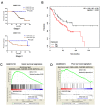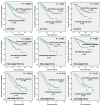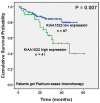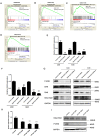KIAA1522 is a novel prognostic biomarker in patients with non-small cell lung cancer
- PMID: 27098511
- PMCID: PMC4838871
- DOI: 10.1038/srep24786
KIAA1522 is a novel prognostic biomarker in patients with non-small cell lung cancer
Abstract
Nowadays, no robust biomarkers have been applied to clinical practice to provide prognostic evaluation of non-small cell lung cancer (NSCLC). This study aims to identify new potential prognostic biomarkers for NSCLC. In the present work, KIAA1522 is screened out from two independent GEO datasets as aberrantly up-regulated gene in NSCLC tissues. We evaluate KIAA1522 expression immunohistochemically in 583 NSCLC tissue samples and paired non-tumor tissues. KIAA1522 displays stronger staining in NSCLC cases than in adjacent normal lung tissues. Importantly, patients with KIAA1522 overexpression had a significantly shorter overall survival compared to those with low expression (P < 0.00001). Multivariate Cox regression analyses show that KIAA1522 is an independent prognostic indicator, even for early-stage NSCLCs (P = 0.00025, HR = 2.317, 95%CI: 1.477-3.635). We also found that high expression of KIAA1522 is a significant risk factor for decreased overall survival of the patients who received platinum-based chemotherapy. Gene set enrichment analysis (GSEA) and functional studies reveal that KIAA1522 is associated with oncogenic KRAS pathways. Taken together, high expression of KIAA1522 can be used as an independent biomarker for predication of poor survival and platinum-resistance of NSCLC patients, and aberrant KIAA1522 might be a new target for the therapy of the disease.
Figures







Similar articles
-
KIAA1522 potentiates TNFα-NFκB signaling to antagonize platinum-based chemotherapy in lung adenocarcinoma.J Exp Clin Cancer Res. 2020 Aug 27;39(1):170. doi: 10.1186/s13046-020-01684-x. J Exp Clin Cancer Res. 2020. PMID: 32854746 Free PMC article.
-
KRAS mutations affect prognosis of non-small-cell lung cancer patients treated with first-line platinum containing chemotherapy.Oncotarget. 2015 Oct 20;6(32):34014-22. doi: 10.18632/oncotarget.5607. Oncotarget. 2015. PMID: 26416458 Free PMC article. Clinical Trial.
-
Down-regulated MicroRNA 148b expression as predictive biomarker and its prognostic significance associated with clinicopathological features in non-small-cell lung cancer patients.Diagn Pathol. 2015 Sep 17;10:164. doi: 10.1186/s13000-015-0393-y. Diagn Pathol. 2015. Retraction in: Diagn Pathol. 2016 Nov 2;11(1):110. doi: 10.1186/s13000-016-0562-7. PMID: 26377406 Free PMC article. Retracted.
-
Prognostic value of KRAS mutation in advanced non-small-cell lung cancer treated with immune checkpoint inhibitors: A meta-analysis and review.Oncotarget. 2017 Jul 18;8(29):48248-48252. doi: 10.18632/oncotarget.17594. Oncotarget. 2017. PMID: 28525386 Free PMC article. Review.
-
Prognostic value of ERCC1 mRNA expression in non-small cell lung cancer, breast cancer, and gastric cancer in patients from Southern China.Int J Clin Exp Pathol. 2014 Dec 1;7(12):8312-21. eCollection 2014. Int J Clin Exp Pathol. 2014. PMID: 25674197 Free PMC article. Review.
Cited by
-
Circ_0020123 promotes NSCLC tumorigenesis via up-regulating KIAA1522 expression through miR-940.Cell Cycle. 2022 May;21(9):894-907. doi: 10.1080/15384101.2022.2034093. Epub 2022 Feb 23. Cell Cycle. 2022. PMID: 35196193 Free PMC article.
-
Identification of the prognostic signature based on genomic instability-related alternative splicing in colorectal cancer and its regulatory network.Front Bioeng Biotechnol. 2022 Jul 18;10:841034. doi: 10.3389/fbioe.2022.841034. eCollection 2022. Front Bioeng Biotechnol. 2022. PMID: 35923577 Free PMC article.
-
Long Non-Coding RNA USP2-AS1 Accelerates Cell Proliferation and Migration in Ovarian Cancer by Sponging miR-520d-3p and Up-Regulating KIAA1522.Cancer Manag Res. 2020 Oct 23;12:10541-10550. doi: 10.2147/CMAR.S268863. eCollection 2020. Cancer Manag Res. 2020. PMID: 33122952 Free PMC article.
-
High KIAA1522 expression predicts a poor prognosis in patients with hepatocellular carcinoma.Oncol Lett. 2020 Jul;20(1):509-516. doi: 10.3892/ol.2020.11588. Epub 2020 May 6. Oncol Lett. 2020. PMID: 32565976 Free PMC article.
-
Advances in Genomic Data and Biomarkers: Revolutionizing NSCLC Diagnosis and Treatment.Cancers (Basel). 2023 Jul 3;15(13):3474. doi: 10.3390/cancers15133474. Cancers (Basel). 2023. PMID: 37444584 Free PMC article. Review.
References
-
- Wen C. & Dehnel T. China wrestles with lung cancer. Lancet Oncol 12, 15 (2011). - PubMed
Publication types
MeSH terms
Substances
LinkOut - more resources
Full Text Sources
Other Literature Sources
Medical
Molecular Biology Databases
Miscellaneous

